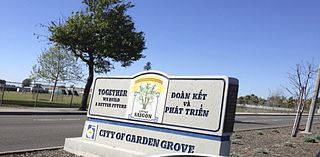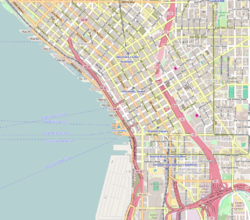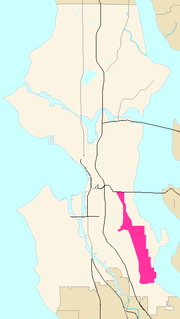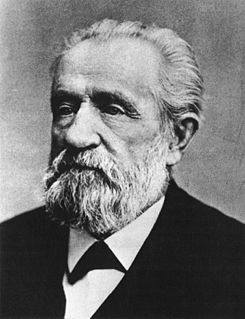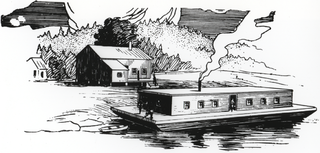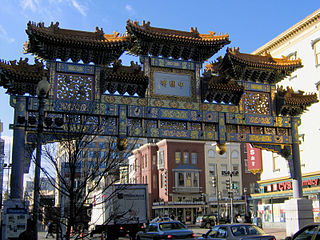
Washington, D.C.'s Chinatown is a small, historic area east of Downtown Washington, D.C., consisting of about 20 ethnic Chinese and other Asian restaurants and small businesses along H and I Streets between 5th and 8th Streets, Northwest. It is also the home to numerous non-Asian stores and businesses, including national and international chains like McDonalds and Starbucks, many of which display their names in Chinese characters. It is known for its annual Chinese New Year festival and parade and the Friendship Arch, a Chinese gate built over H Street at 7th Street. Other nearby prominent landmarks include the Capital One Arena, a sports and entertainment arena, and the Old Patent Office Building, which houses two of the Smithsonian Museums. The neighborhood is served by the Gallery Place station of the Washington Metro.
Oklahoma City's Asia District, also known as the Asian District, is the center of Asian culture and International cuisine and commerce in the state of Oklahoma. It contains the largest population of Asian Americans and descendants from Asia in the state.

Chinatowns in Asia are widespread with a large concentration of overseas Chinese in East Asia and Southeast Asia and ethnic Chinese whose ancestors came from southern China - particularly the provinces of Guangdong, Fujian, and Hainan - and settled in countries such as Brunei, Cambodia, East Timor, Indonesia, India, Laos, Malaysia, Myanmar, the Philippines, Singapore, Sri Lanka, Taiwan, Thailand, Vietnam, Japan and Korea centuries ago—starting as early as the Tang Dynasty, but mostly notably in the 17th through the 19th centuries, and well into the 20th century. Today the Chinese diaspora in Asia is largely concentrated in Southeast Asia however the legacy of the once widespread overseas Chinese communities in Asia is evident in the many Chinatowns that are found across East, South and Southeast Asia.

An Asian supermarket is a category of grocery stores in Western countries that stocks items imported from the multiple countries in East, South and Southeast Asia. Supermarkets in Asia generally have no equivalent to the "Asian" supermarkets of the West; foodstuffs in each respective Asian country have vastly different regulations and supply chains from one another, so stores are localized for each country's tastes and only carry locally approved items for that market. Examples of this: seaweed snacks, originate in Japan where they are salty or savory, in Thailand they are often spicy and locally produced.
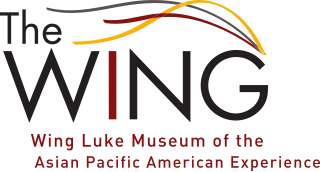
The Wing Luke Museum of the Asian Pacific American Experience is a history museum of the culture, art and history of Asian Pacific Americans located in Seattle, Washington's Chinatown-International District, founded in 1967. It is a Smithsonian Institution affiliate, and the only pan-Asian Pacific American community-based museum in the US. In February 2013 it was recognized as one of two dozen affiliated areas of the U.S. National Park Service.

The Chinatown neighborhood in Oakland, California(Chinese: 屋崙華埠), is a pan-Asian neighborhood which reflects Oakland's diverse Asian American community. It is frequently referred to as "Oakland Chinatown" in order to distinguish it from nearby San Francisco's Chinatown. It lies at an elevation of 39 feet.

Old Town Chinatown is the official Chinatown of the Northwest section of Portland, Oregon. The Willamette River forms its eastern boundary, separating it from the Lloyd District and the Kerns and Buckman neighborhoods. It includes the Portland Skidmore/Old Town Historic District and the Portland New Chinatown/Japantown Historic District, which are listed on the National Register of Historic Places.
This is an alphabetical index of topics related to Asian Americans.

International District/Chinatown is a light rail and bus station that is part of the Downtown Seattle Transit Tunnel in Seattle, Washington. The station is located at the tunnel's south end, at 5th Avenue South and South Jackson Street in the Chinatown-International District neighborhood. It is served by the Central Link, part of Sound Transit's Link light rail system, as well as buses from King County Metro and Sound Transit Express. The station is located adjacent to Sound Transit headquarters at Union Station, as well as intermodal connections to Amtrak and Sounder commuter rail at King Street Station, the First Hill Streetcar, and intercity BoltBus service.
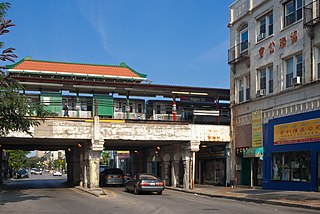
The West Argyle Street Historic District is a historic district in the northern Uptown, a commercial district of Chicago, Illinois. It was listed on the National Register of Historic Places on June 3, 2010. The community covers an area of about 41 acres (0.17 km2); its rough boundaries are N. Glenwood Ave to the west, Winona Street to the north, Sheridan Road to the east, and Ainslie Street to the south. It was home to the Essenay Studios in the 1920s founded by Charlie Chaplain, a producer of silent movies before relocating to Southern California in Hollywood. Essenay Studios now is home to St. Augustine College.
This article contains a list of the Chinatowns, which are either officially designated neighborhoods or historically important in the United States. Historically speaking, many of these Chinatowns were formed in the 1800s and have served as ethnic enclaves.

One of the largest Vietnamese neighborhoods in Philadelphia is located in Passyunk Square, a neighborhood in South Philadelphia.

Greater Seattle has had a Chinese American community almost since its founding in 1851. Chinese workers arriving in the 1860s were welcomed, because the Seattle area was sparsely settled and workers were needed; within a few decades, however, newly arrived white settlers resented the Chinese workers, and there were several anti-Chinese riots as the whites attempted to expel the Chinese from the area. Chinese settlement persisted, with the immigrants settling in a well-defined Chinatown where they maintained their culture through family groups, associations, and churches. In the mid-20th century Chinese Americans joined with other immigrant groups to oppose racial discrimination. In 1962 a Chinese American became the first person of Asian ancestry to hold elective office in the state of Washington.

The Historic Chinatown Gate is a modern Paifang archway in the Chinatown-International District neighborhood of Seattle, Washington. The 45-foot-tall (14 m) archway is located over South King Street east of 5th Avenue South and the International District/Chinatown light rail station, marking the west end of the Chinatown neighborhood. The gate, designed by Paul Wu and Ming Zhang of MulvannyG2 Architecture of Bellevue, Washington, was built over a period of several months in late 2007 and is composed of a steel structure and ceramic ornaments, including 8,000 ceramic tiles made in southern China. The $500,000 construction cost was paid for by the Historic Chinatown Gate Foundation, a non-profit organization established in 1999 to build the archway. The Historic Chinatown Gate was dedicated on February 9, 2008 during a ceremony attended by local officials, including Seattle mayor Greg Nickels and Governor Christine Gregoire.
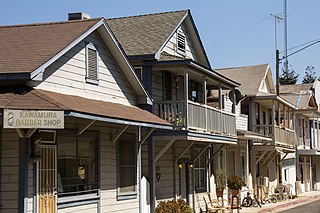
The Walnut Grove Japanese-American Historic District is a 5-acre (2.0 ha) designated U.S. Historic District in Walnut Grove, California. The bulk of Walnut Grove's Japantown was built in 1915–16 following the 1915 fire which destroyed Walnut Grove's Chinatown. Japantown was depopulated during the forced incarceration of Japanese and Japanese-Americans following the issuance of Executive Order 9066 in 1942, and was re-filled by Filipino and Mexican laborers, who took over work in local orchards and farms during the war. Although the original residents returned to Walnut Grove following the end of World War II, most left within a few years, and the district, with some exceptions, to this day retains the original architecture and style dating back to the 1916 reconstruction.





